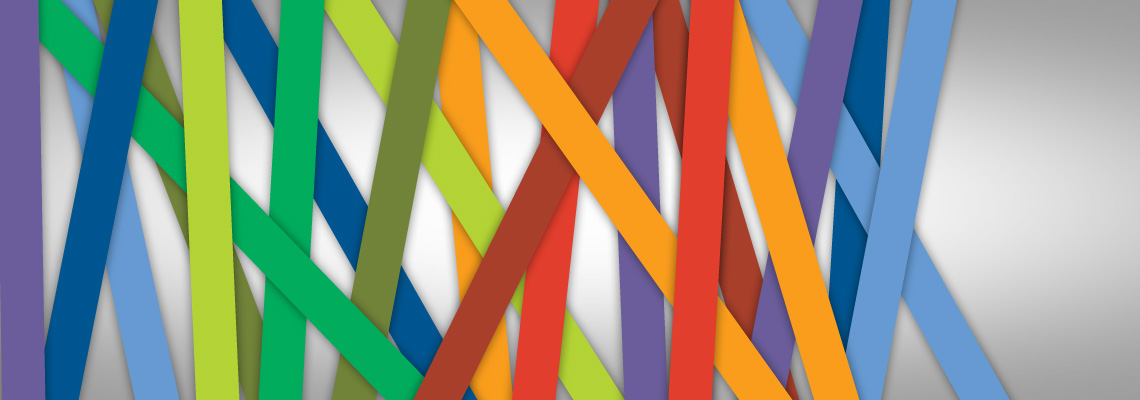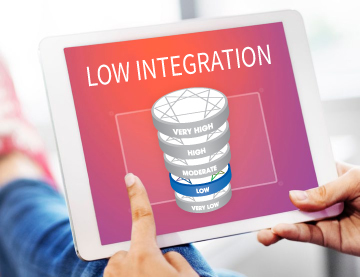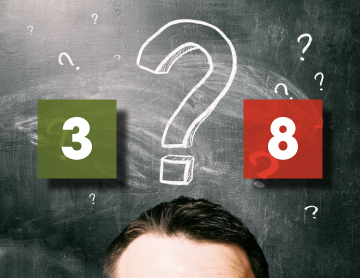Often, we hear people asking the same question after they have spent some time getting to grips with their Enneagram Type. It usually goes something along the lines of, “Okay, now that I understand a little bit about my Enneagram Type and my core motivations and how these drive my behaviour, where exactly do I go from here?”
There is, of course, a considerable amount of work that one can do just around deepening their understanding of his or her core Enneagram Type. There is so much room for growth just in that itself. However, there is certainly something to be said for alternative areas of development offered through the Enneagram lens. One of these rests on our efforts to access the Ennea points that lie on our lines. An example of this for an Ennea 5 would be accessing and scooping from the gifts of Ennea 7 and Ennea 8, or for an Ennea 1, accessing the gifts of Ennea 4 and Ennea 7.
In this article, we look at the Lines of Stretch and Release and the inherent polarity that the lines represent for each Ennea Type. We will also look at the benefits of using embodiment exercises to more effectively access the high side of the two Ennea points which lie on our lines for powerful personal growth and development.
Lines of Stretch and Release
At Integrative Enneagram Solutions, we prefer a more developmental approach to the Lines. In our experience and research, we find it just as likely that people can move towards and integrate the higher or more positive influences of the so-called disintegration point, or take on less-useful qualities of the integration point. So rather than referring to the Lines of Disintegration and Integration, we refer to the Lines of Stretch and Release.
"The Lines of Stretch and Release offer beautiful pathways to stretch into other powerful ways of being that bring fresh resources and balance a person’s natural style or comfort zone. "
Given that the Enneagram is a dynamic system, we are not limited to just one Enneagram Type in the system; in fact, we often access and scoop from the other Enneagram Types depending on our needs and circumstances. So, whilst our basic Ennea Type is our ‘home base’, we can intentionally (and more often unintentionally) draw on other Enneagram Types. When we do intentional, directed work to inhabit the other Enneagram Types, we experience a significant shift in our experience of ourselves. Typically, when we do inhabit any of the other Enneagram Types, because we employ their lenses as overlays of our own core Ennea lens, we may present with a very different point of view and style of behaviour.
"We begin to notice small and sometimes large shifts, and often even the people around us notice it. Sometimes these shifts can be unsettling and uncomfortable; however, if we manage them properly, they can be very fruitful for our personal growth and development. "
When we access other Enneagram Types for personal change via our Lines of Stretch and Release, we need to be aware that there is both a ‘low side’ and a ‘high side’ of behaviour attached to each Ennea Type. Our focus should be on accessing the high side. By ‘high side’, we mean the integrated, healthy aspects and characteristics of that Ennea Type. When we access the low integration behaviours of that Ennea Type, it may strengthen our defence mechanisms and anxieties or lead to an unfulfilling response to the challenges we are facing. The reality is that every person has the potential to access the high side of the points on either end of the lines associated with their Ennea Type. And, whilst the work to access the high side of the Line of Stretch might be somewhat more difficult than the work entailed to access the high side of the Line of Release, both points are equally important for well-rounded growth.
Let’s take a look at some examples:
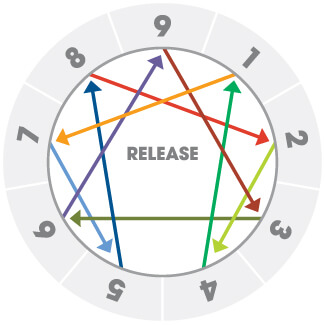
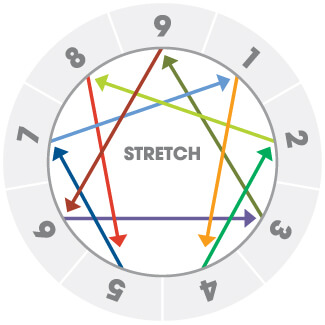
Example 1: An Ennea 3 with a motivational need to outshine others and be the best accessing Ennea 9 via the Line of Stretch and Ennea 6 via the Line of Release.
The Line of Stretch into Ennea 9 offers the Ennea 3 an opportunity to learn the power of collaboration, to relax, to broaden the focus of attention, to understand genuine humility and importantly to consciously let go of the need to control things, by allowing himself or herself to follow others a little more.
The Line of Release into Ennea 6 offers the Ennea 3 an opportunity to slow down, access fears and uncertainties, connect to personal feelings and preferences and have more faith in others, allowing them to recognise and accept the support of others to get things done.
Example 2: An Ennea 8 with a motivational need to be strong and avoid vulnerability accessing Ennea 5 via the Line of Stretch and Ennea 2 via the Line of Release.
The Line of Stretch into Ennea 5 offers the Ennea 8 an opportunity to spend time alone, to dive into developing a depth of understanding and deep expertise and the personal time and space to work on self-regulation (for example, containing emotions such as anger).
The Line of Release into Ennea 2 offers the Ennea 8 an opportunity to get in touch with their more tender, compassionate side, to become attuned to others’ needs and feelings, to focus on building others up, being vulnerable and yielding to others.
"We can see that by identifying our Lines of Stretch and Release, we open ourselves up to a new set of resources for our personal development journey. This set of resources adds tremendous value and enables us to find the balance that we may otherwise be lacking if we rely solely on our core Ennea Type. Accessing the dynamic points of Stress and Release Lines can help us see alternative options and, most importantly, become less stuck in our habitual patterns of behaviour."
The Polarity of the Lines
Whether you are working on your own development journey or coaching and supporting others in their journeys, the layers of the Enneagram unquestionably inform the growth and development process.
The power of our Lines of Stretch and Release relate to the manner in which they help us embrace the paradox and polarity of who we are. Moving dynamically to explore the types on either end of these lines allows us to explore the statement “I am also what I say I am not”.
Going back to the example of the Ennea 3, when they are able to access the Line of Stretch to Ennea 9 and the Line of Release to Ennea 6, they might begin to see that focusing their attention on achieving goals, being efficient and garnering the respect and admiration of others doesn’t prevent them from pausing to reflect on potential threats and paying attention to their feelings and intuitions (Ennea 6), or just ‘being’ and connecting to others and their perspectives and opinions (Ennea 9).
Clearly then, moving along the lines offers a significant shift in perspective which allows us to step out of our typical style and create new ways to respond to the world around us. The lines, therefore, offer rich potential for exploration and development. They offer balance and fresh resources to our core Ennea Type; though it is important to remember that each Enneagram Type is related to those on the other end of the line as a polarity or paradox to be lived into. Ideally, we want to develop the ability to be fluent in the lines as a continuum, as a path of movement for our integrated self.
Physically Walking the Lines
We should understand that the Lines of Stretch and Release represent an energy flow; there is no literal movement around the Enneagram. We understand that the lines symbolically or structurally represent the natural pathway towards higher and lower levels of integration within our core Ennea Type. Having said this, there is something unique and powerful about using embodiment exercises on what we call the Enneagram Carpet or Mat.
As we work to scoop from the gifts of the points on our Lines of Stretch and Release, there is a natural tendency to revert to our core Ennea Type with its familiar patterns of behaviour and the comforts of the ‘known’. Enneagram coaches will, however, explain that if we can retain the lessons of these other points on the Enneagram for long and often enough, we can better leverage these gifts and integrate them into our core Ennea Type for genuine and sustainable personal development.
We have found that one of the best ways to reflect the flow of energy and bring the magic of the Enneagram alive for people using it for personal growth and development, is for them to physically walk the lines associated with their core Ennea Type. With the use of a 3x3 metre carpet with the Enneagram diagram printed clearly on it, individuals are able to stand on their core Ennea Type and then physically walk up and down the lines, consciously taking on the high-side of the points they step into.
Here are some examples of how these embodiment exercises might play out using the Integrative Enneagram Solutions Carpet:
- An individual challenged by a seemingly unresolvable dilemma can begin by standing on the space of his or her core Ennea Type. Using Core Type and Wings, the individual might be able to gain more clarity about the nature of the challenge and then, by walking the Lines of Stretch and Release and physically standing on the two points, the individual will use each of the points as inspiration and a source for an alternative approach to the challenge. Through embodiment and actually standing on the type, the individual is asked to take on the qualities and characteristics of that type, which opens their mind to otherwise unthought of ideas.
- An individual who is seemingly suffering from ‘rust out’ or an absence of strain, might be challenged to find the impetus for change. By walking the Line of Stretch, and embodying the point in the Enneagram, the individual might be better able to reflect on areas of dissatisfaction (coming at the reflection from a different perspective), thereby increasing their experience of dissatisfaction and harnessing energy for change.
- An individual who is seemingly experiencing elevated stress and strain levels might find the source of energy for change by walking the Line of Release. In accessing a healthy pathway that enables coping and releases or alleviates tension to a point where action then becomes possible, they are able to (re)engage with the personal development journey.
Conclusion
Indeed, we have witnessed how something magical happens when individuals who have previously struggled with their personal development journeys, plant their feet on the carpet and move up and down the lines to find clarity and new patterns of behaviour that better serve their needs. Accessing and walking the lines of the Enneagram, whether literally or figuratively, unquestionably opens a whole new set of opportunities and possibilities for those seeking growth and development.

 What is the Enneagram?
What is the Enneagram?
 Introduction to the 27 Subtypes
Introduction to the 27 Subtypes
 Introduction to the 3 Centers
Introduction to the 3 Centers
 Wings
Wings
 Lines and Integration
Lines and Integration
 Enneagram History & Origin
Enneagram History & Origin
 Enneagram for Myself
Enneagram for Myself
 Enneagram for Practitioners
Enneagram for Practitioners
 Enneagram for Business
Enneagram for Business
 iEQ9 Individual Reports
iEQ9 Individual Reports
 iEQ9 Team Reports
iEQ9 Team Reports
 iEQ9 Questionnaire
iEQ9 Questionnaire
 Training Events
Training Events
 Level 1 iEQ9 Accreditation
Level 1 iEQ9 Accreditation
 Level 2 Enneagram Team Dynamics
Level 2 Enneagram Team Dynamics
 International Enneagram Conference
International Enneagram Conference
 iEQ9 Community of Practice Events
iEQ9 Community of Practice Events
 About Integrative9
About Integrative9
 Meet the Faculty
Meet the Faculty
 Testimonials
Testimonials
 Contact Us
Contact Us
